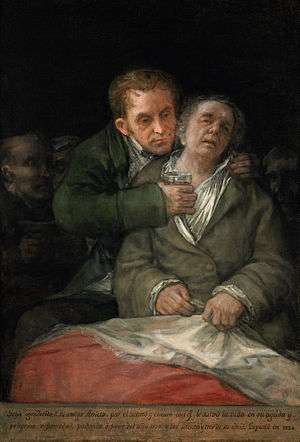Self-portrait with Dr Arrieta
Self-portrait with Dr Arrieta is the English title given to a painting by Spanish artist Francisco Goya. The work is an oil on canvas, painted in 1820. It is held in the Minneapolis Institute of Art, Minnesota.
| Self-portrait with Dr Arrieta | |
|---|---|
 Inscription (bottom of canvas in brown): Goya agradecido, à su amigo Arrieta: por el acierto y esmero con g.e le salvò la vida en su aguda y peligrosa enfermedad, padecido à fines de año 1819, a los setenta y tres de su edad. Lo pintó en 1820. | |
| Artist | Francisco de Goya |
| Year | 1820 |
| Medium | Oil on canvas |
| Dimensions | 114.62 cm × 76.52 cm (45.13 in × 30.13 in) |
| Location | Minneapolis Institute of Art, Minnesota |
Background
In 1792, Goya developed a sudden serious illness which included dizziness, weakness, delirium, sickness, abdominal pain, deafness, and partial blindness.[1][2] By the time he returned to Madrid, in 1793, Goya was completely deaf. Various diagnoses of this serious illness have been offered: syphilis, lead poisoning, cerebrovascular disease, acute infection of the central nervous system, and the rare condition of Vogt-Koyanagi-Harada syndrome—temporary inflammation of the uveal tract associated with permanent deafness.[3] In 1819 Goya had a second serious illness. Little information is available either on the nature of the illness or on the treatment provided by Eugenio García Arrieta. The painting is the main source, and an inscription (in the manner of ex-voto pictures) below the figures explains why Goya made the picture: “Goya, in gratitude to his friend Arrieta: for the compassion and care with which he saved his life during the acute and dangerous illness he suffered towards the end of the year 1819 in his seventy-third year.[4] He painted it in 1820“. Robert Hughes writes that "a faint clue to the nature of Goya's malady may lie in the fact that Dr. Arrieta is known to have gone to North Africa in 1820 to study Eastern plague. Epidemics of such plagues, which included yellow fever, happened from time to time in Spain because of contagions brought by Mediterranean shipping. Since Arrieta was considered a plague specialist, Goya may have been strricken by such a virus. But this is highly speculative."[5]
The work
Goya is seated on his bed obviously weak from his illness. He grasps his bed-sheet as if clinging on to life and is supported from falling backwards by the arm of Arrieta. The doctor gently encourages his patient to take the medicine. Shadowy figures—perhaps his servants and a priest—in the background seem to be portents of doom. Goya may have expected to die, but under Arrieta's care, he was nursed back to health and lived another eight years. Self Portrait with Dr Arrieta is an image of hope amidst despair and the colours are correspondingly more delicate and lighter than in other works of this period.[6]
History
The work was a present for Arrieta. It was painted in gratitude for the gift of life, not as a memento mori. It is uncertain how long the painting remained in Arrieta's possession. In 1820 he traveled to Africa to study bubonic plague, and it is probable that the painting remained in Spain. By 1860, when exhibited in Madrid, it was in the collection of Mr Martinez of Madrid. Later the painting was recorded in various private collections in Paris before being acquired by the Minneapolis Institute of Art.[7]
References
- Foy J. L. The Deafness and Madness of Goya: Conscious and Unconscious Expressive Art. Vol 3. Basel: Karger, 1971. (Cited in M.P. Park and R.H.R. Park, "The Fine Art of Patient-Doctor Relationships." BMJ 329 (2004): p. 1,475, and notes 1, 2.)
- Cawthorne, Terrance. "Goya's Illness." Proc Roy Soc Med 55 (March 1962): 213–217.
- Cawthorne Terrance. "Goya's Illness." Proc Roy Soc Med 55 (March 1962): 213-217.
- Licht, Fred. Goya--The Origins of the Modern Temper in Art. New York: Harper and Row, 1983.
- Hughes, Robert (2003). Goya. New York: Knopf. pp. 373. ISBN 0394580281.
- McEwan, John. John Bellany. Edinburgh and London: Mainstream Publishing, 1994.
- McEwan John. John Bellany. Edinburgh and London: Mainstream Publishing, 1994.